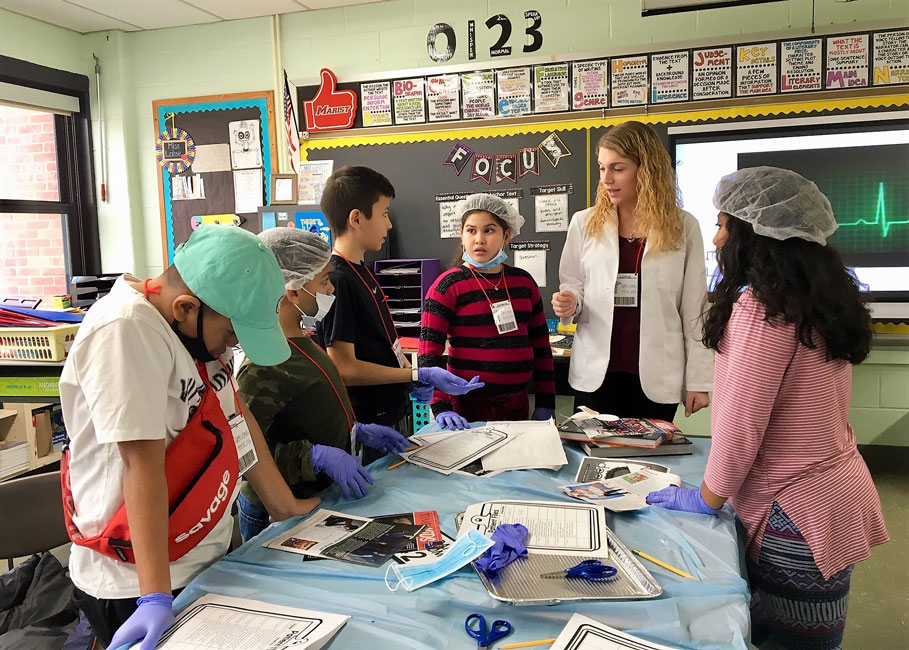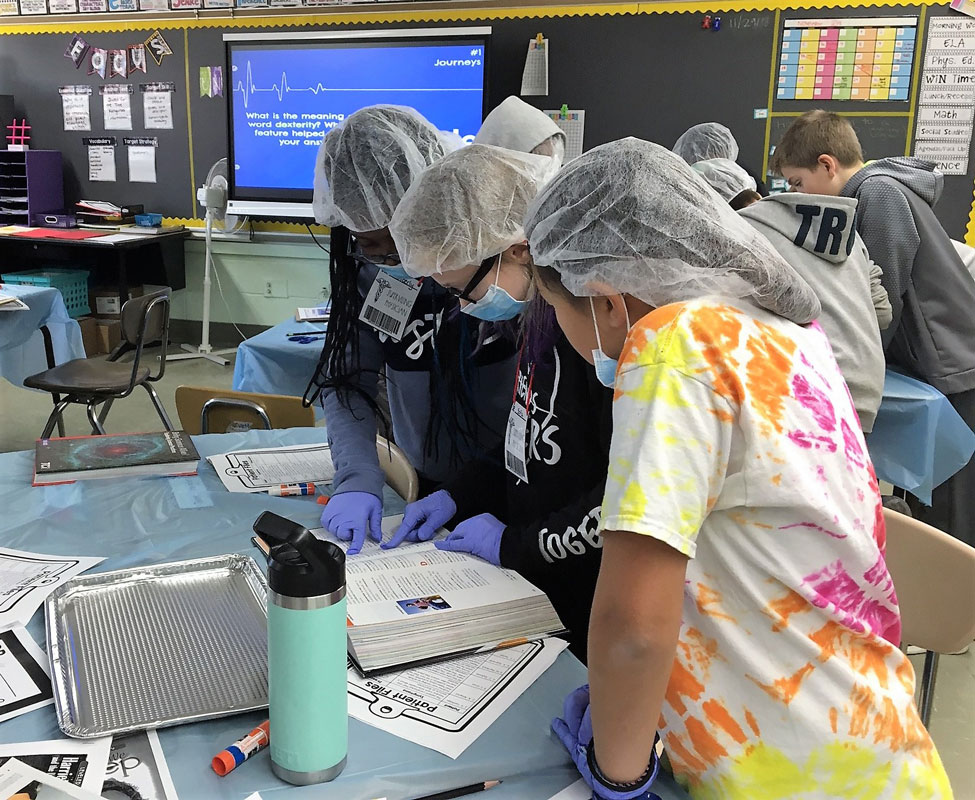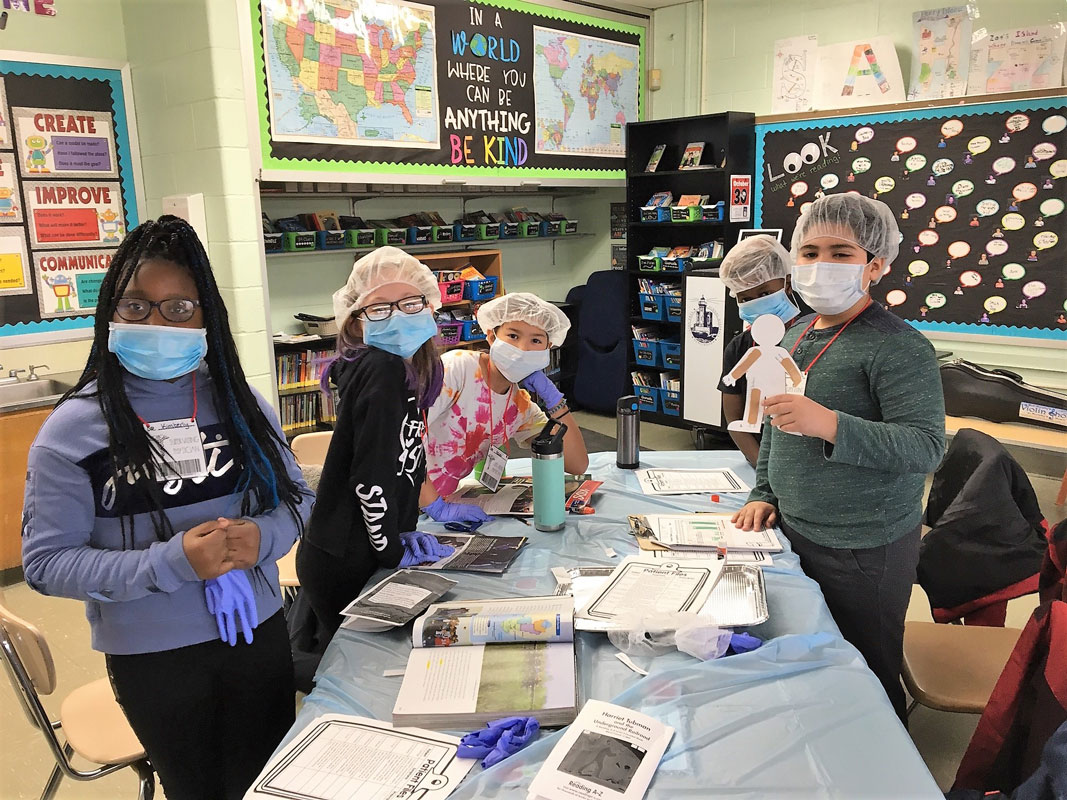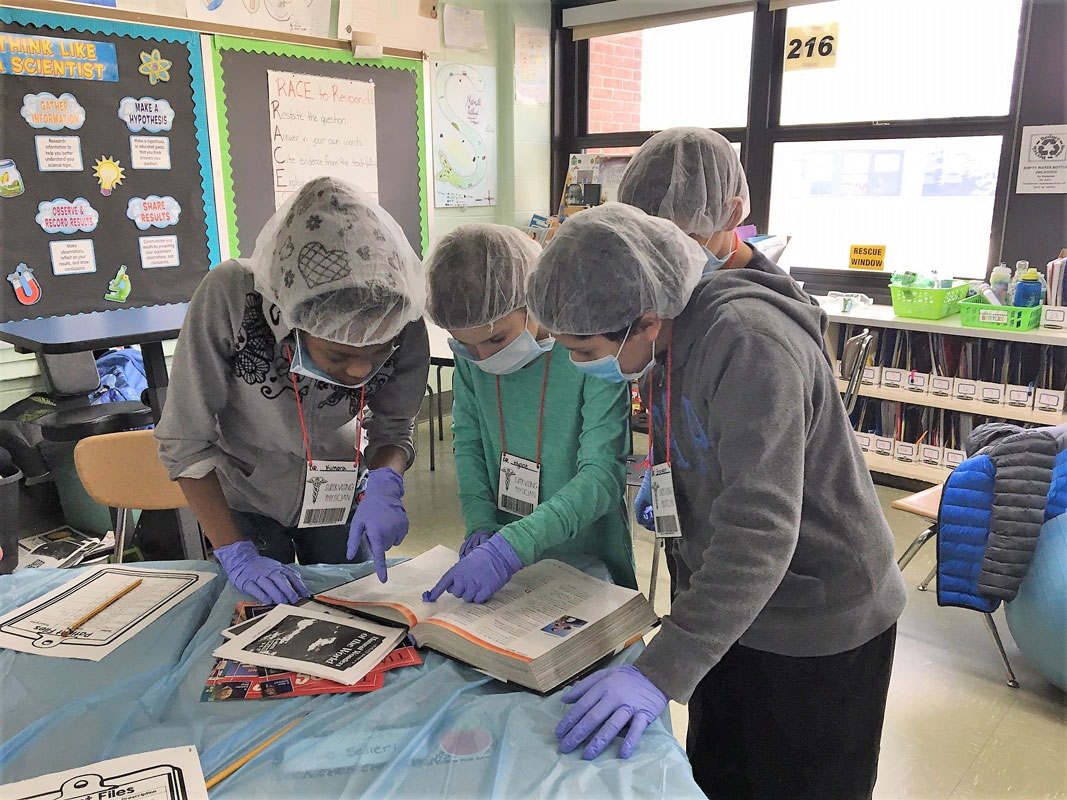Teacher Emily Lohse couldn’t wait to treat her fifth grade students at Jack Abrams STEM Magnet School to a new educational technique known as “classroom transformation.”
Students in both sections of Ms. Lohse’s English Language Arts classes were in for a surprise when they walked into their classroom on what would have otherwise been a regular Thursday morning.
The youngster’s desks, which are typically arranged in neat rows, were organized in a way to create large tables and covered in blue tablecloths. Metal trays held rubber gloves, hair nets and face masks and the outline of a human body was on each table alongside a packet of medical records and a stack of non-fiction books and magazines. A heart rate monitor could be heard beeping softly in the background and Ms. Lohse, was wearing a medical doctor’s coat and badge.
Immediately upon entering the room, students were given identification badges of their own and were told that they were no longer students, but top surgeons at Jack Abrams STEM Hospital and they were urgently needed to perform “text feature surgery” on some ailing patients.
“One of our building goals is to increase student engagement and no doubt this lesson delivered in a big way,” Principal Donna Morro said. “The best part is that not only were students excited and interested in learning in class that day, but student retention of the information increased as well.
The STEM students were grouped into teams of four and assigned to an “operating room.” Each member of the group was given a job, ranging from patient prepper, surgeon or stitcher to the lead supervisor, who was tasked with reporting back to the class. Each team was also given a set of patient files describing the “symptoms” of patients who were struggling to understand non-fiction text.
Students had to read and analyze the patient’s symptoms to determine which text feature would meet the patients’ needs, using their prior knowledge from previous lessons on non-fiction text features. They then had to locate and cut-out examples of the correct text feature in various non-fiction “donor” texts and “implant” the examples into the patients’ files.
Code Blue emergencies
Wearing their gloves, face masks and hair nets, students worked diligently on their surgeries. Suddenly, a loud alarm sounded and all of the students stopped; it was a Code Blue emergency! At the sound of the alarm, all surgeons had been instructed to stop what they were doing and answer a question that appeared on the board, using text features in either their Journeys or TCI Science textbook. Students had to write the answer to the question, as well as the text feature that helped them on the arm or leg of their patient before they could get the approval (in the form of a Band-Aid) to continue with their surgery.
Code Blue emergencies happened sporadically throughout the activity, adding an element of surprise and excitement, but also requiring students to apply the skills they were actively practicing to the textbooks they regularly use in class.
Ms. Lohse was inspired to transform her classroom into a hospital by examples she had seen online. “Classroom transformations are a trend that are sweeping the educational side of social media,” she said.
Originally conceived by award-winning educators Hope and Wade King as part of their “set the stage to engage” movement, a classroom transformation is a learning experience in which a teacher alters the classroom environment to increase student engagement and enrich student learning. “A classroom transformation makes the learning feel more real and memorable because students become immersed in another world, rather than their familiar classroom,” Ms. Lohse said. “The work students do during these transformations are typically rigorous and require higher-level thinking, but students are motivated to put their best effort into the task.”
The impact of the classroom transformation
Ms. Lohse said she could definitely see the impact of the classroom transformation on her own students. “Text features are such an important part of non-fiction reading because they help the reader make sense of what they are reading or provide additional information that can enhance students’ understanding of a topic,” the second year Huntington teacher said. “Traditionally, students are taught these features and expected to memorize them and they are quickly forgotten. The text feature surgery was unique because rather than just memorizing a list of features, students had to apply their knowledge to an engaging scenario. It was an event that they won’t soon forget.”
Ms. Lohse is a graduate of Eastport South Manor High School. She obtained an undergraduate degree at Marist College in psychology and education in 2015 and earned a master’s degree at St. Joseph’s College in literacy and cognition in 2017. She completed her student teaching requirements in a K-2 special education class at Noxon Road Elementary School and in a fifth grade classroom at Vail Farm Elementary School.
After a stint as a permanent sub at Eastport Elementary School (2015/16) and as a full year leave replacement at East Moriches Elementary School (2016/17), Ms. Lohse came to Huntington UFSD last year. She is also the Jack Abrams STEM Magnet School computer club faculty advisor.
“My students still jokingly refer to me as Doctor Lohse even weeks later and I’ve noticed that they always stop to point out text features as we read in class, where before they would typically breeze past them,” Ms. Lohse said. “This was my first transformation and while it took a lot of work to set up, it was worth the effort and it’s something I’m definitely looking forward to doing again!”



